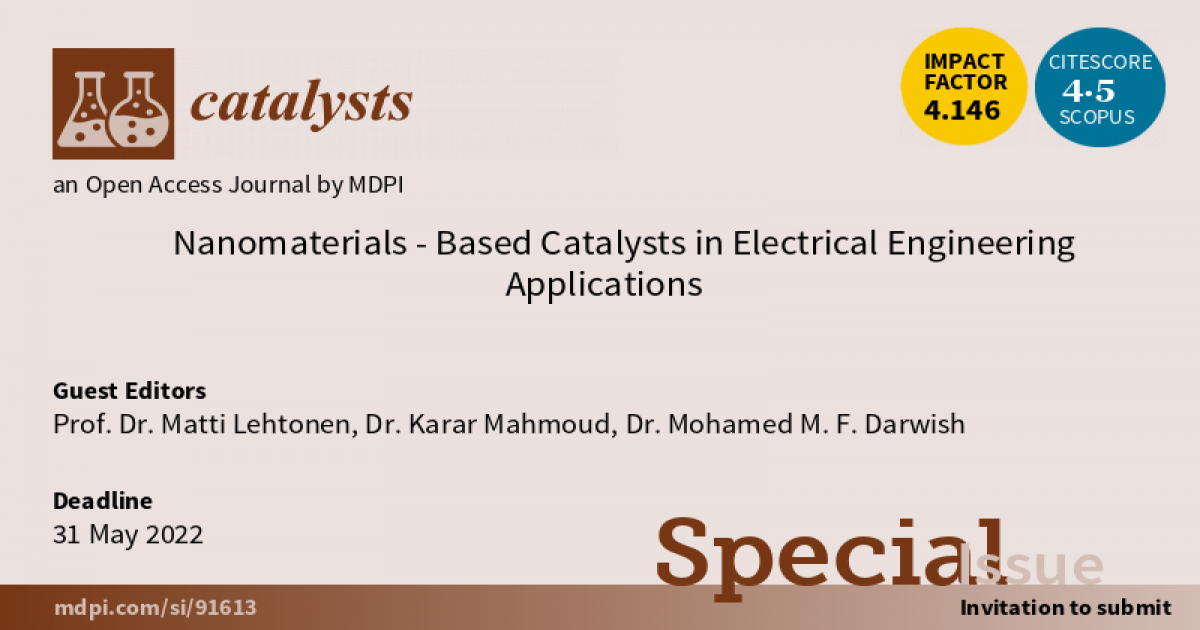Nanomaterials-Based Catalysts in Electrical Engineering Applications
A special issue of Catalysts (ISSN 2073-4344).
Deadline for manuscript submissions: closed (31 May 2022) | Viewed by 1446

Special Issue Editors
Interests: power and energy systems; demand response; power grids; renewable energy sources; power system economics; electrical load modeling; electric vehicle charging; energy storages; heating system electrification
Special Issues, Collections and Topics in MDPI journals
Interests: power systems; energy storage; electrical vehicles; renewable energy; smart grids; applied machine learning
Special Issues, Collections and Topics in MDPI journals
2. Department of Electrical Engineering, Benha University, Cairo 11629, Egypt
Interests: nanoparticles; polymer nanocomposites; nanofluids; thin films; functionalization; characterization; electrical insulating materials; dielectric, mechanical, and thermal properties; renewable energies; Industry 4.0
Special Issue Information
Dear Colleagues,
These days, a second generation of nanomaterials is being explored called "multi-functional materials". In this regard, the power of this promising nanotechnology in electrical power applications is still exciting. With respect to these advanced materials, fabrication and processing take more prominence in determining the properties exhibited by the prepared materials. Nanomaterial-based catalysts are considered a global technological direction towards efficient electrical power components.
Notably, the introduction of these new materials into electrical products has brought with it a necessary reflection on the impacts of their characteristics on the short-, mid- and long-term life and end-of-life of specific electrical applications (e.g., cables, transformers, substation equipment, capacitors, high voltage insulator, circuit breaker, photovoltaic solar cells, wind turbine insulation arms, and rotating machines). This trend has just started worldwide, especially in electrical applications, and it was judged worthy to present a comprehensive overview of the current actions and trends involving regulations and reservations relative to the nanomaterial-based catalysts. For instance, the electrical power industry seeks to create a super dielectric material, in addition to a superconducting material, that can enhance the breakdown strength or conducting current together with higher thermal conductivity whilst maintaining its physical, chemical, and mechanical performances.
This Special Issue aims to cover the most recent progress and advances in the fabrication of a new multi-functional material that can be used in electrical applications by using nanotechnology. This advancement includes various applications but is not limited to cables, transformers, substation equipment, capacitors, high-voltage insulators, circuit breakers, photovoltaic solar cells, wind turbine insulation arms, rotating machines, and electric traction. It is expected that various improvements will be noticed in all properties after doping the nanoparticles, which are considered to be efficient catalysts, inside the neat particles of the electrical material with homogenous dispersion.
Prof. Dr. Matti Lehtonen
Prof. Dr. Karar Mahmoud
Dr. Mohamed M. F. Darwish
Guest Editors
Manuscript Submission Information
Manuscripts should be submitted online at www.mdpi.com by registering and logging in to this website. Once you are registered, click here to go to the submission form. Manuscripts can be submitted until the deadline. All submissions that pass pre-check are peer-reviewed. Accepted papers will be published continuously in the journal (as soon as accepted) and will be listed together on the special issue website. Research articles, review articles as well as short communications are invited. For planned papers, a title and short abstract (about 100 words) can be sent to the Editorial Office for announcement on this website.
Submitted manuscripts should not have been published previously, nor be under consideration for publication elsewhere (except conference proceedings papers). All manuscripts are thoroughly refereed through a single-blind peer-review process. A guide for authors and other relevant information for submission of manuscripts is available on the Instructions for Authors page. Catalysts is an international peer-reviewed open access monthly journal published by MDPI.
Please visit the Instructions for Authors page before submitting a manuscript. The Article Processing Charge (APC) for publication in this open access journal is 2200 CHF (Swiss Francs). Submitted papers should be well formatted and use good English. Authors may use MDPI's English editing service prior to publication or during author revisions.
Keywords
- Nanomaterial-based catalysts in electrical applications
- Polymer nanocomposites, nanofluids, and nanogas sensors
- Functionalized nanoparticles
- Preparation and characterization
- Electrical, thermal, mechanical, physical, and chemical properties
- Renewable energies
- Energy storage systems
- Power system components (cables, transformers, capacitors, machines, etc.)
- High-voltage engineering
Benefits of Publishing in a Special Issue
- Ease of navigation: Grouping papers by topic helps scholars navigate broad scope journals more efficiently.
- Greater discoverability: Special Issues support the reach and impact of scientific research. Articles in Special Issues are more discoverable and cited more frequently.
- Expansion of research network: Special Issues facilitate connections among authors, fostering scientific collaborations.
- External promotion: Articles in Special Issues are often promoted through the journal's social media, increasing their visibility.
- Reprint: MDPI Books provides the opportunity to republish successful Special Issues in book format, both online and in print.
Further information on MDPI's Special Issue policies can be found here.







